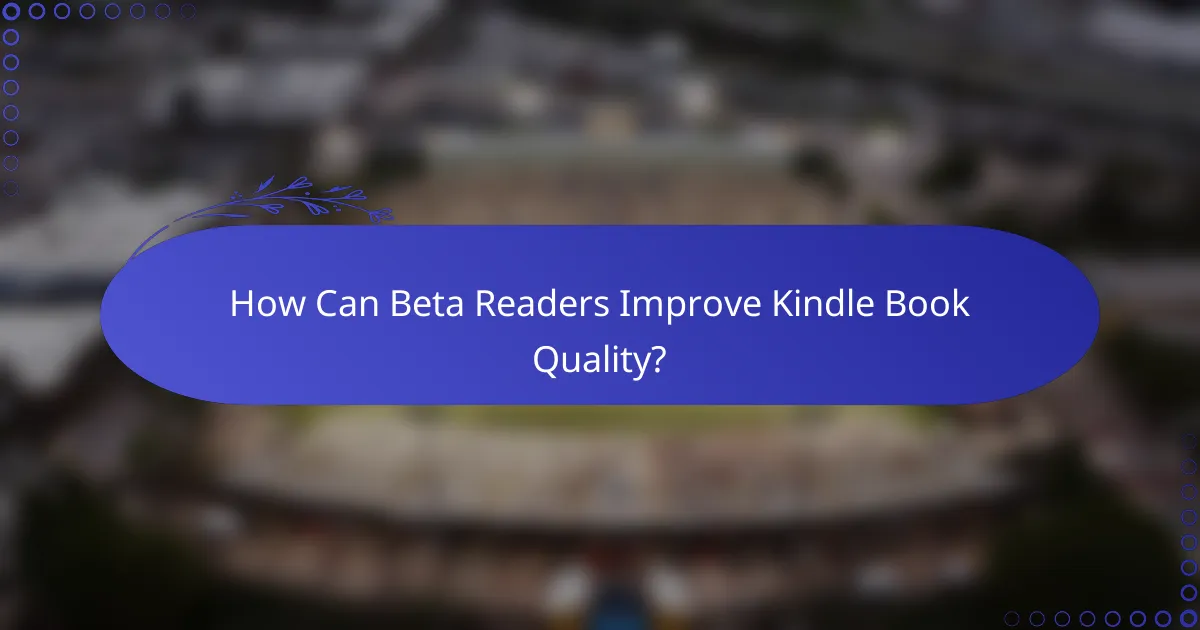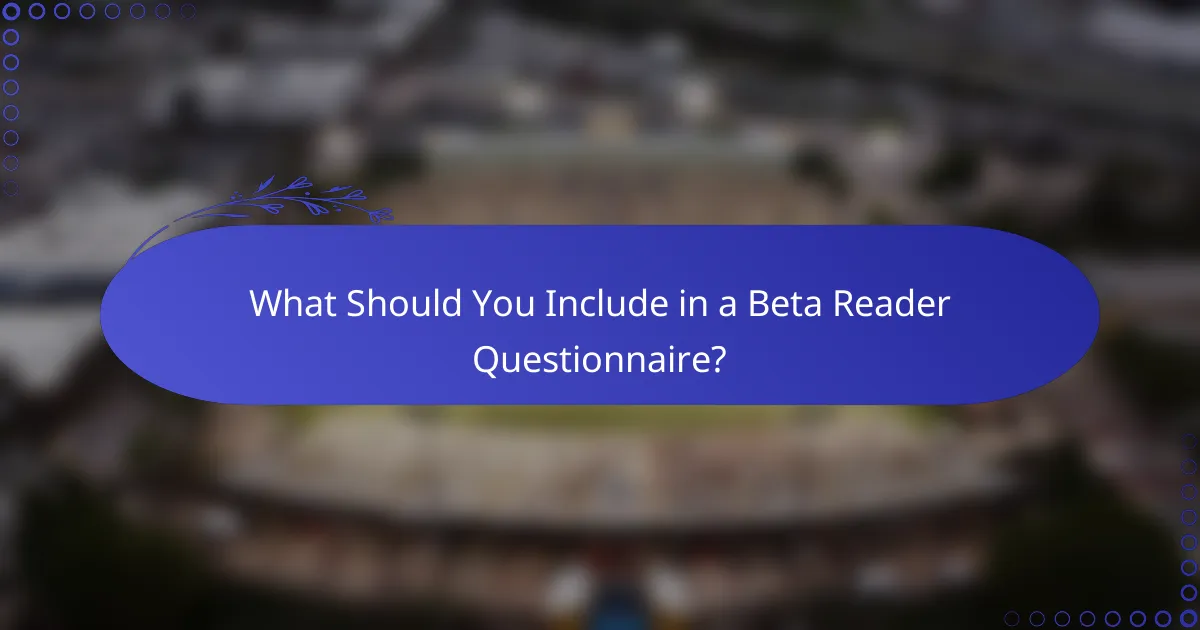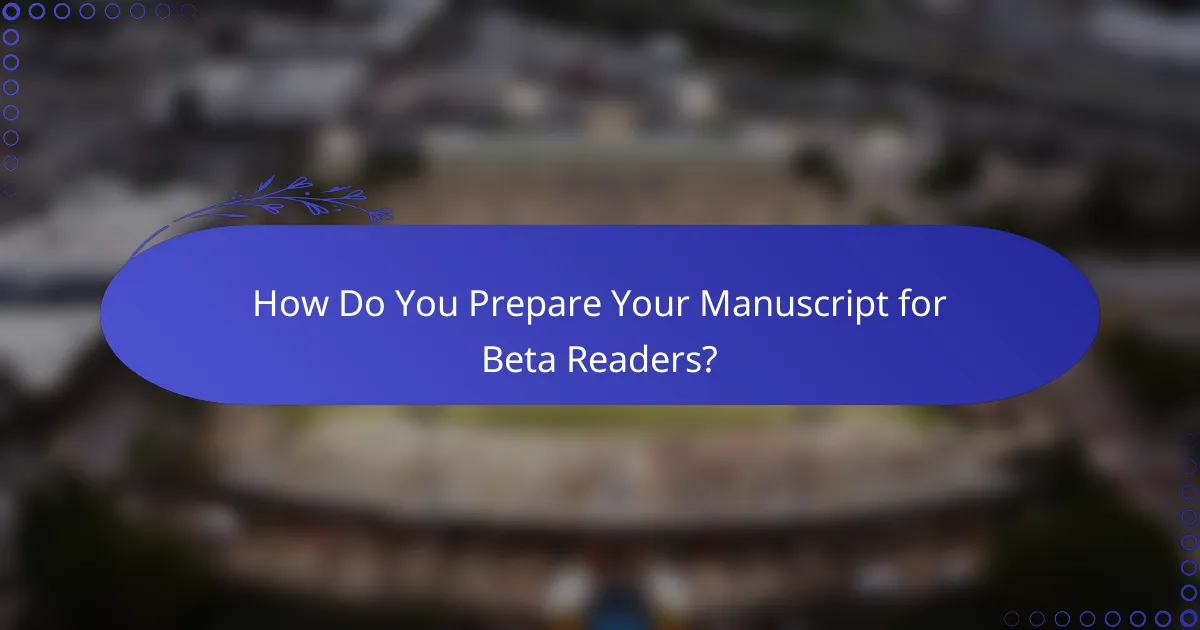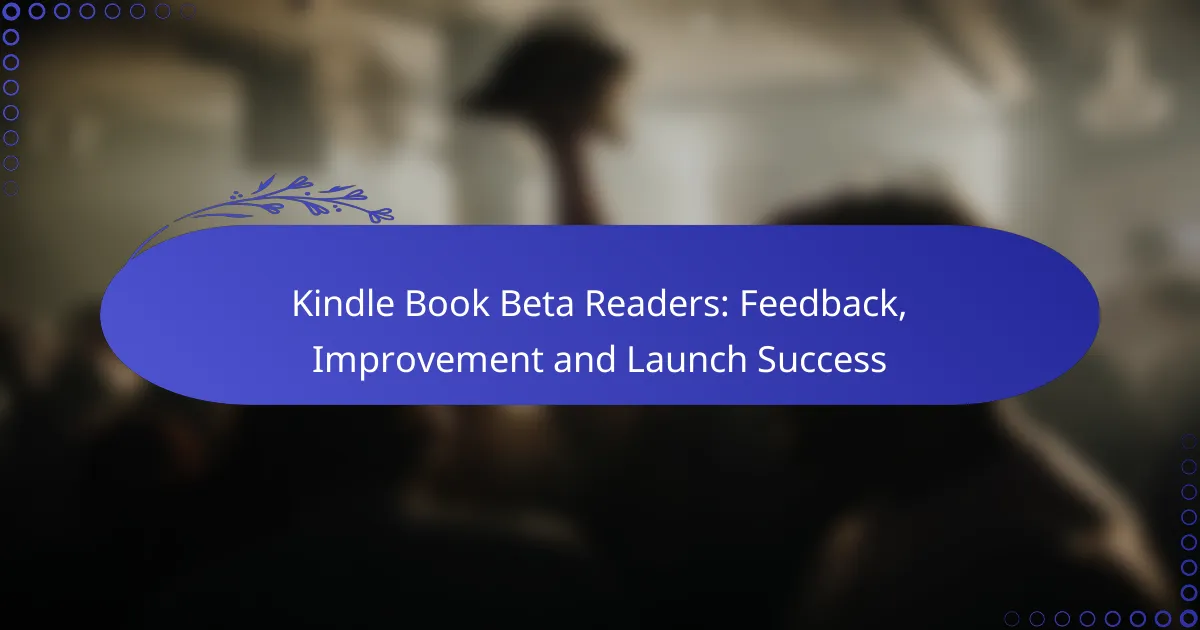Beta readers are essential for refining your Kindle book, offering critical feedback that enhances its quality before launch. By utilizing effective strategies to find and engage these readers, authors can gather valuable insights that address weaknesses and improve the overall manuscript. A well-crafted beta reader questionnaire can further guide the feedback process, focusing on key aspects such as character relatability and plot clarity to ensure the final product resonates with its audience.

How Can Beta Readers Improve Kindle Book Quality?
Beta readers play a crucial role in enhancing the quality of a Kindle book by providing valuable insights and feedback during the writing process. Their perspectives help authors identify weaknesses and areas for improvement, ultimately leading to a more polished final product.
Identifying plot holes
Beta readers can effectively spot plot holes that may confuse readers or disrupt the story’s flow. They can point out inconsistencies in the narrative or elements that lack proper resolution, which the author may overlook during the writing process.
To address plot holes, authors should encourage beta readers to ask questions about the story’s logic and coherence. A simple checklist for beta readers could include: Are all character motivations clear? Do events logically follow one another? Is the ending satisfying?
Enhancing character development
Character development is essential for engaging readers, and beta readers can provide insights into whether characters are relatable and well-rounded. They can highlight characters that feel flat or underdeveloped, allowing authors to refine their personalities and arcs.
Authors should ask beta readers specific questions about character motivations and growth. For instance, do readers understand why a character makes certain choices? Are the characters’ actions consistent with their established traits?
Refining pacing and structure
Beta readers can help authors assess the pacing and structure of their Kindle book, ensuring that the story maintains reader interest throughout. They can identify sections that drag or feel rushed, allowing authors to make necessary adjustments.
To refine pacing, authors might consider asking beta readers to note any parts where they felt bored or confused. A good practice is to create a pacing chart, marking key events and transitions to visualize the story’s flow.
Providing honest feedback
Honest feedback from beta readers is invaluable for authors looking to improve their work. Constructive criticism helps identify strengths and weaknesses, guiding authors toward necessary revisions.
Authors should create a safe environment for feedback by assuring beta readers that their honesty is appreciated. Providing a structured feedback form can help guide readers in delivering clear, actionable insights.
Suggesting genre-specific improvements
Beta readers familiar with the book’s genre can offer targeted suggestions that align with reader expectations and conventions. They can help ensure that the story adheres to genre norms while still offering a fresh perspective.
Authors should seek feedback on elements such as tone, style, and thematic consistency. For example, a romance novel may require a focus on emotional depth, while a thriller might need tighter suspense and pacing.

What Are Effective Strategies for Finding Beta Readers?
Effective strategies for finding beta readers include leveraging social media, engaging with writing communities, offering incentives, and networking at literary events. These approaches can help you connect with individuals who are willing to provide valuable feedback on your Kindle book.
Utilizing social media platforms
Social media platforms like Facebook, Twitter, and Instagram are excellent tools for finding beta readers. Join groups or follow hashtags related to writing and reading to connect with potential readers who share your interests.
Consider posting about your search for beta readers on your own profile or in relevant groups. Be clear about what you need from them and what they can expect in return, such as a free copy of your book.
Engaging with writing communities
Writing communities, both online and offline, are valuable resources for finding beta readers. Websites like Wattpad, Scribophile, or local writing clubs can connect you with fellow authors and readers who are eager to provide feedback.
Participate actively in these communities by offering critiques on others’ work. This reciprocity can encourage members to return the favor and read your manuscript.
Offering incentives for feedback
Offering incentives can motivate potential beta readers to engage with your work. Consider providing free copies of your book, gift cards, or even a mention in your book’s acknowledgments as rewards for their feedback.
Clearly communicate what you expect from them in terms of feedback quality and timelines. This will help ensure that you receive constructive and timely responses.
Networking at literary events
Networking at literary events such as book fairs, author signings, or writing workshops can help you find beta readers in person. These gatherings attract individuals who are passionate about literature and may be interested in reading your work.
Prepare a brief pitch about your book and what type of feedback you are seeking. Carry business cards or flyers with your contact information to distribute to potential beta readers you meet.

What Should You Include in a Beta Reader Questionnaire?
A beta reader questionnaire should focus on gathering specific feedback that helps improve your manuscript before launch. Key areas to explore include character relatability, pacing and engagement, and plot clarity to ensure your book resonates with readers.
Character relatability questions
Character relatability is crucial for reader engagement. Ask beta readers if they found the characters believable and relatable. Questions could include: “Which character did you connect with the most and why?” or “Did any character’s actions seem unrealistic?”
Consider including a scale for readers to rate their connection to each character. This can help you identify which characters resonate well and which may need more development or backstory.
Pacing and engagement queries
Pacing affects how readers experience your story. Include questions that assess whether the story maintained their interest throughout. For example, “Were there any sections where you felt bored or lost?” or “Did the story keep you engaged from start to finish?”
Encourage readers to provide feedback on specific chapters or scenes that felt too slow or rushed. This insight can guide you in adjusting the pacing to enhance overall engagement.
Plot clarity and coherence prompts
Ensuring that your plot is clear and coherent is essential for reader comprehension. Ask beta readers if they understood the main storyline and if any plot points were confusing. Questions like “Did you find any plot twists predictable or unclear?” can yield valuable insights.
Consider asking for feedback on the overall structure of the plot. A simple checklist can help readers identify if they found the beginning, middle, and end satisfying and logically connected.

How Do You Prepare Your Manuscript for Beta Readers?
Preparing your manuscript for beta readers involves refining your content to ensure clarity and engagement. This includes editing for grammar and style, formatting for readability, and providing clear context and guidelines for feedback.
Editing for grammar and style
Editing is crucial for presenting a polished manuscript to beta readers. Focus on correcting grammatical errors, improving sentence structure, and ensuring consistent style throughout the text. Tools like Grammarly or Hemingway can assist in identifying issues.
Consider reading your manuscript aloud to catch awkward phrasing or unclear passages. This technique helps you identify areas that may confuse readers and allows you to refine your language for better flow.
Formatting for readability
Proper formatting enhances the reading experience for beta readers. Use standard fonts like Times New Roman or Arial, with a font size of 12-14 points, and maintain consistent line spacing of 1.5 or double spacing to improve readability.
Incorporate headings, bullet points, and short paragraphs to break up large blocks of text. This structure helps readers navigate your manuscript easily and focus on key points without feeling overwhelmed.
Providing context and guidelines
When sending your manuscript to beta readers, include a brief overview of your book’s themes and objectives. This context helps them understand your vision and the type of feedback you are seeking.
Additionally, provide specific guidelines on what aspects to focus on, such as character development, pacing, or plot clarity. Clear instructions will lead to more targeted and useful feedback, ensuring a smoother revision process.

What Are Common Feedback Themes from Beta Readers?
Beta readers often provide valuable insights into key themes such as character motivations, plot consistency, and emotional impact. Understanding these themes can significantly enhance the quality of your manuscript and increase its chances of success upon launch.
Character motivations
Feedback on character motivations helps authors ensure that their characters’ actions align with their goals and personalities. Readers may point out inconsistencies, suggesting that a character’s decisions feel forced or unconvincing. It’s crucial to develop clear motivations that resonate with the audience, as this can deepen their connection to the story.
To gauge character motivations effectively, consider asking beta readers specific questions about what drives each character. This can help identify any areas where motivations may need clarification or enhancement. For instance, if a character’s sudden change in behavior is confusing, it may indicate a need for more backstory or development.
Plot consistency
Plot consistency is essential for maintaining reader engagement. Beta readers often highlight discrepancies in the storyline, such as unresolved subplots or contradictions in events. Ensuring that all plot points are logically connected and contribute to the overall narrative arc can prevent reader frustration.
To assess plot consistency, create a timeline of events in your story and check for logical flow. Encourage beta readers to note any moments where they felt lost or confused. Addressing these issues early can lead to a more cohesive and satisfying reading experience.
Emotional impact
The emotional impact of a story can significantly influence reader satisfaction. Feedback in this area often revolves around whether the story evokes the intended feelings, such as joy, sadness, or tension. If beta readers report a lack of emotional engagement, it may indicate that certain scenes need more depth or authenticity.
To enhance emotional impact, focus on developing relatable characters and situations that resonate with readers. Consider using vivid imagery and sensory details to draw readers into pivotal moments. Asking beta readers how they felt during key scenes can provide insights into what works and what may need adjustment.
